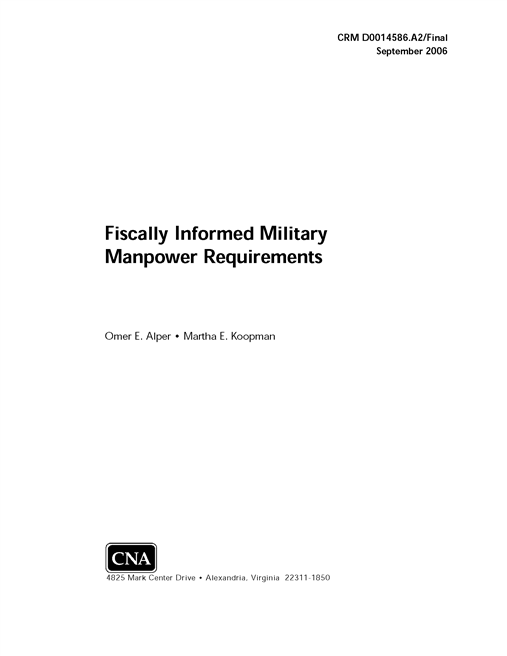There is concern that requirements for the Navy’s military manpower are being developed with insufficient attention to cost. In this sense, today’s requirements may be called “fiscally uninformed.” While today’s requirements may be sufficient to accomplish the mission, it is important that they accomplish the mission at lowest cost. In this study, we describe the current manpower requirements determination process, identify why requirements are not fiscally informed, and develop ideas for more market-based, cost-informed requirements determination.
The Navy's requirements determination process consists of two stages. In the first stage, requirements without considering constraints on funds are generated by taking fleet and shore command inputs through industrial engineering models. For fleet activities, this process is centralized and run by N1’s Navy Manpower and Material Analysis Center (NAVMAC). For shore activities, this process is much more decentralized. Once these requirements have been generated, the Plan ning, Programming, Budgeting, and Execution System (PPBES) takes over, and the decision of what billets to fund is made. This decision is made by an interaction among N1 as the Single Resource Sponsor (SRS) for manpower, the Navy Enterprises, the Budget Submitting Offices (BSOs), and N8.
Recent changes in the PPBES system—namely, N1 becoming SRS for manpower and the creation of Navy Enterprises—have yet to fully play out. The most important feature of the SRS structure is that con- trol of the entire military personnel budget is transferred from the traditional Resource Sponsors (RSs) to N1. On one hand, this change gives the greatest promise of the new system—the ability to innovate and to streamline the process. On the other hand, it is the most troublesome aspect because RSs will no longer have the ability to trade off manpower for other appropriations. Although these changes will occur in other areas, we have seen little evidence to suggest that these changes in and of themselves will materially affect the cost incentives facing BSOs and their field activities.
The lack of fiscally informed requirements in the current system stems from the incentives created by certain features of the PPBES process. In particular, the Navy’s BSOs and their field activities have more information about actual operations under their control, but they are not able to make tradeoffs between all of their resources. If they give up military billets, or request extra military billets, they do not typically get the associated savings or pay the costs. The costs or savings go into the general Military Personnel (MilPers) account or go to their RS but are generally not traced back to the BSO.
Thus, an organization at the field level, with the best knowledge regarding how military manpower should be structured by rank and skill, as well as how military manpower should be traded for other types of manpower and capital, may not have the best incentives to use manpower efficiently. For one thing, it may not use its knowledge to innovate and obtain better knowledge about how to reduce manpower costs. At worst, it may be reluctant to reveal its knowledge of possible innovations and savings for fear of losing MilPers funding without gaining the needed Operations and Maintenance (O&M) funding to make necessary expenditures for technology, government civilians, or contractor labor.
We find some evidence that Navy activities have historically reduced civilian manpower more than military manpower. Such behavior is consistent with the different cost incentives that activities face for the two types of manpower. Savings from civilian manpower are retained in an activity’s O&M budget and can be redirected toward a host of alternate resources, whereas the activity would lose any military manpower savings. In addition, evidence suggests that several types of activities that we would expect to make more cost-informed military manpower requirements decisions, such as working-capital-funded activities, have indeed reduced military manpower at a greater rate than their peer activities.
Download reportApproved for Public Release; Distribution Unlimited.
Details
- Pages:
- Document Number: CRM D0014586.A2/Final
- Publication Date: 9/22/2006
